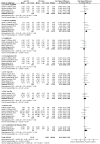Corneal collagen cross-linking in keratoconus: a systematic review and meta-analysis
- PMID: 25007895
- PMCID: PMC5381610
- DOI: 10.1038/srep05652
Corneal collagen cross-linking in keratoconus: a systematic review and meta-analysis
Abstract
The aim of this study was to determine the effectiveness of corneal collagen cross-linking (CXL) for the treatment of progressive keratoconus (KC). Some of the published literature, including a few small, randomized controlled trials (RCTs), demonstrated good results after CXL, but large RCTs with long-term follow-up to establish a cause-effect relationship are lacking. Using PubMed, EMBASE, and the Cochrane Library database, we searched for relevant studies published between October 2007 and March 2014. A comprehensive literature search was performed using the Cochrane Collaboration methodology to identify the effectiveness of CXL for treating KC. The primary outcome parameters included uncorrected visual acuity (UCVA), best-corrected visual acuity (BCVA), refraction, corneal topography, and corneal thickness at baseline and at 1, 3, 6, 12, and 18 months after CXL. A total of 1171 participants (1557 eyes) were enrolled in this meta-analysis. CXL may be effective in halting the progress of KC for at least 12 months under certain conditions. However, further research from randomized trials is needed to confirm our findings.
Conflict of interest statement
The authors declare no competing financial interests.
Figures



Similar articles
-
Optical Performance of the Cornea One Year Following Keratoconus Treatment with Corneal Collagen Cross-Linking.Curr Eye Res. 2018 Dec;43(12):1415-1421. doi: 10.1080/02713683.2018.1501802. Epub 2018 Jul 30. Curr Eye Res. 2018. PMID: 30012019
-
Efficacy and safety of transepithelial corneal collagen crosslinking surgery versus standard corneal collagen crosslinking surgery for keratoconus: a meta-analysis of randomized controlled trials.BMC Ophthalmol. 2017 Dec 28;17(1):262. doi: 10.1186/s12886-017-0657-2. BMC Ophthalmol. 2017. PMID: 29282020 Free PMC article. Review.
-
Prospective, randomized contralateral eye study of accelerated and conventional corneal cross-linking in pediatric keratoconus.Int Ophthalmol. 2019 May;39(5):971-979. doi: 10.1007/s10792-018-0898-y. Epub 2018 Mar 21. Int Ophthalmol. 2019. PMID: 29564806 Clinical Trial.
-
Pediatric Corneal Cross-linking: Comparison of Visual and Topographic Outcomes Between Conventional and Accelerated Treatment.Am J Ophthalmol. 2017 Nov;183:11-16. doi: 10.1016/j.ajo.2017.08.015. Epub 2017 Aug 31. Am J Ophthalmol. 2017. PMID: 28864070
-
Comparison of standard and accelerated corneal cross-linking for the treatment of keratoconus: a meta-analysis.Acta Ophthalmol. 2019 Feb;97(1):e22-e35. doi: 10.1111/aos.13814. Epub 2018 May 31. Acta Ophthalmol. 2019. PMID: 29855152 Review.
Cited by
-
Corneal collagen cross-linking for treating keratoconus.Cochrane Database Syst Rev. 2015 Mar 24;2015(3):CD010621. doi: 10.1002/14651858.CD010621.pub2. Cochrane Database Syst Rev. 2015. PMID: 25803325 Free PMC article.
-
Visual and Topographic Outcomes of Corneal Collagen Cross Linking for Post LASIK Ectasia.Clin Ophthalmol. 2022 Jun 20;16:2025-2032. doi: 10.2147/OPTH.S370033. eCollection 2022. Clin Ophthalmol. 2022. PMID: 35757019 Free PMC article.
-
Outcomes of Corneal Topography among Progressive Keratoconus Patients 12 months following Corneal Collagen Cross-Linking.Clin Ophthalmol. 2021 Jan 7;15:49-55. doi: 10.2147/OPTH.S284981. eCollection 2021. Clin Ophthalmol. 2021. PMID: 33442228 Free PMC article.
-
Eccentric Pathology in Keratoconus Exhibits Stiffer Biomechanical Response than Central Pathology.Ophthalmol Sci. 2024 Dec 20;5(3):100682. doi: 10.1016/j.xops.2024.100682. eCollection 2025 May-Jun. Ophthalmol Sci. 2024. PMID: 40165909 Free PMC article.
-
The efficacy of standard versus accelerated epi-off corneal cross-linking protocols: a systematic review and sub-group analysis.Int Ophthalmol. 2019 Nov;39(11):2675-2683. doi: 10.1007/s10792-019-01091-y. Epub 2019 Jun 20. Int Ophthalmol. 2019. PMID: 31222533
References
-
- Romero-Jimenez M., Santodomingo-Rubido J. & Wolffsohn J. S. Keratoconus: a review. Cont. Lens Anterior Eye 33, 157–166; quiz 205 (2010). - PubMed
-
- Maeno A., Naor J., Lee H. M., Hunter W. S. & Rootman D. S. Three decades of corneal transplantation: indications and patient characteristics. Cornea 19, 7–11 (2000). - PubMed
-
- Alio J. L., Pinero D. P. & Daxer A. Clinical outcomes after complete ring implantation in corneal ectasia using the femtosecond technology: a pilot study. Ophthalmology 118, 1282–1290 (2011). - PubMed
-
- Raiskup F. & Spoerl E. Corneal crosslinking with riboflavin and ultraviolet A. Part II. Clinical indications and results. Ocul. Surf. 11, 93–108 (2013). - PubMed
Publication types
MeSH terms
Substances
LinkOut - more resources
Full Text Sources
Other Literature Sources

